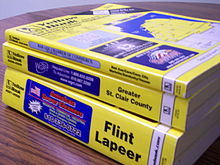Telephone directory

A telephone directory (also called a telephone book and phone book) is a listing of telephone subscribers in a geographical area or subscribers to services provided by the organization that publishes the directory.
Content

Subscriber names are generally listed in alphabetical order, together with their postal or street address and telephone number. Every subscriber in the geographical coverage area is usually listed, but subscribers may request the exclusion of their number from the directory, often for a fee. Their number is then said to be "unlisted" (American English), "ex-directory" (British English) or "private" (Australia and New Zealand).
In the case of unlisted numbers, practices as to Caller-ID vary by jurisdiction. Sometimes, the Caller-ID on outbound calls is blank; in other jurisdictions, unlisted numbers still appear, unless the caller dials a blocking code; in still others, the customer may request automatic blocking from the telephone company's service representatives.
In some countries under current rules and practices, mobile phone and Voice over IP listings are not included in telephone directories. Efforts to create cellular directories have met stiff opposition from several fronts, including a significant percentage of subscribers who seek to avoid telemarketers.
In 1991, the U.S. Supreme Court ruled (in Feist v. Rural) that telephone companies do not have a copyright on telephone listings, because copyright protects creativity and not the mere labor of collecting existing information. Within the geographical reach of the Court, the Feist ruling has resulted in the availability of many innovative telephone directory services on CD-ROM and the World Wide Web.
Publication
Telephone directories can be published in hard copy or in electronic form. In the latter case, the directory can be provided as an online service through proprietary terminals or over the Internet, or on physical media such as CD-ROM.
In France, the Minitel videotex system originated as an attempt by France Télécom to rid itself of its paper publishing costs by forcing all telephone users to use Minitel terminals instead.
In Switzerland, most pay phones are now accompanied with electronic telephone directory terminals instead of paper directories, and phone users are charged for each search.
Types
A telephone directory may also be called a phone book or may be known by the color of the paper it is printed on.
- White pages generally indicates personal or alphabetic listings.
- Yellow pages, sometimes called the A2Z, generally indicates a business directory classified by business type or services provided, almost always with paid advertising.
- In Ireland and in Hungary it is called the Golden Pages [1] [2] and is available in print and online.
- Grey pages, sometimes called a "reverse telephone directory".
- Other colors may have other meanings, depending on a country's customs. Information on government agencies is often printed on blue or green pages.
Ancillary content
A telephone directory may also provide instructions about how to use the telephone service in the local area, may give important numbers for emergency services, utilities, hospitals, doctors and organizations who can provide support in times of personal crisis. It may also have civil defense or emergency management information. There may be transit maps, postal code guides, or stadium seating charts, as well as advertising.
History

The first telephone directory, consisting of a single page, was issued on February 21, 1878. It covered 50 subscribers in New Haven, Connecticut. The Reuben H. Donnelly company asserts that it published the first classified directory, or yellow pages, for Chicago, Illinois, in 1886. The first British telephone directory was published in 1880.
Reverse directories
A reverse telephone directory is sorted by number, which can be looked up to give the name and address of the subscriber. Reverse telephone directories are used by law enforcement and other emergency services in order to determine the origin of any request for assistance. These systems include both publicly accessible (listed) and private (unlisted) services. As such, these directories are restricted to internal use only. Publicly accessible reverse telephone directories may be provided as part of the standard directory services from the telecommunications carrier in some countries.
Phone books in popular culture
Ripping phone books in half has often been considered a feat of strength.
Phone books have been used to help small children sit up higher at tables.
See also
External links
- De Telefoongids - The Online White and Yellow Pages for the Netherlands
- goldenpages.ie - The Online Business Listings Phonebook for Ireland
- eircomphonebook.ie - The Online Residential Phonebook for Ireland
- Online Phonebook for US and Canada
- Phonebook of the World
- World Telephone Directories Listing of most of the world's online telephone directories
- Canada's Yellow Pages(TM)
- United Kingdom Yellow Pages
- United Kingdom Business Directory
- Intelibell
- Online Telephone Directory for India
- Insider Pages
- InfoUSA
- Canada 411 Canada's official White Pages
- Editable white pages for US & Canada
- Eco Yellow Pages How to stop unsolicited delivery of phone books
